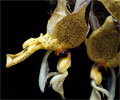|
|
|
|
|
| |
Flasks of
Stanhopea wardii 'CC9443' × self |
|
| |
|
|
| |
| Number: |
TN9003 |
| Name: |
Stanhopea wardii 'CC9443' × self
|
| Type: |
self (What's that?) |
|
Seed Donor: |
Troy C. Meyers
|
|
Click to Enlarge

Pod Parent Flower |
Click to Enlarge

Pod Parent Inflorescence |
|
|
|
| |
For additional origin/habitat information supplied courtesy of
Charles and Margaret Baker, see further below, near the bottom of this page.
|
Temperatures we attempt to use in the lab & greenhouse:
| For Species: |
|
Spring, Summer, Autumn, Winter: days average 79°F, nights 59°F; best fit is Cool-Intermediate 75-58°F
(Source:
Baker's Web OSC) |
|
About the name...
| Etymology of |
Stanhopea |
|
In honor of Philip Henry, 4th Earl of Stanhope, president of the London Medico-Botanical Society during the early part of the 19th century.
(Source:
Pridgeon 1992) |
| Etymology of |
wardii |
|
Named for Dr. E. Ward, English orchid enthusiast and collector of the 19th century.
(Source:
Mayr & Schmucker 1998) |
| Pronunciation of |
Stanhopea |
|
stan-HOPE-ee-ah
(Source:
Pridgeon 1992) |
| Pronunciation of |
wardii |
|
WARD-ee-eye
(Source:
Hawkes 1978) |
|
If you would like to direct someone to this web page, please copy and paste this URL into your email:
http://troymeyers.com/d?019003
| Flask Information |
| Availability: |
We have sold all of the flasks for this item. |
| You should: |
Consider getting individual plants or compots instead of a flask.
See if we have plants available in the greenhouse. |
| Yield Estimate: |
150 plants (based on flask surveys done 08/12/2021 through 08/04/2022)
|
| Plantlet Sizes: |
From many flasks 30 - 80 mm plants (based on flask surveys done 12/22/2021 through 08/04/2022)
From one most recently surveyed flask 50 - 80 mm (08/04/2022)
|
|
You might also want to:
|
View the seed assay for this item.
See if we have plants available in the greenhouse.
View items of the same species.
View items of the same genus.
|
| Ordering Information |
| You are not currently logged in. |
|
You must be a registered user and be logged in to reserve a flask or place a notification request. Please log in:
|
|
|
|
|
|
| |
The origin/habitat information below is supplied courtesy of Charles and Margaret Baker
The following information is based on the name of the plant provided by the donor, and assumes that the name is correct. If the plant has been misidentified, then the following information may not be correct.
This text is copyrighted by the Bakers and may not be reproduced without permission.
ORIGIN/HABITAT: Southern Central America and northern South America.
Present thinking is that this orchid is only found south of Honduras, with
the range of distribution including Nicaragua, Costa Rica, Panama,
Venezuela, and Colombia. It was first collected near Caracas, Venezuela
and has since been found as various locations in the region. Dunsterville
and Garay (1959) reported that plants have been found near Caracas at
Mariposa dam. Foldats (1970) reported that plants were found at 2600-5900
ft. (800-1800 m) in the National Park in the District of Aragua. In
Colombia, plants grow in the northern part of the country, north of the
Departments of Antioquia and Chocó, at 5900-8200 ft. (1800-2500 m). In
Costa Rica, S. wardii is native to the Costa Rican Meseta Central, east
and southeast of Cartago and the adjacent Reventazon area at nearly 4450
ft. (1350 m). It grows on old trees covered with spanish moss and masses
of bromeliads, particularly Tillandsias. In Panama, the orchid is common
throughout the intermediate highlands on the Pacific slope of Coclé and
Chiriquí Provinces at 1800-4000 ft. (550-1220 m).
Plants collected in El Salvador near Boquerón and in the Cerro Grande de
Apaneca at 4900 ft. (1500 m) were originally discussed as S. wardii by
Hamer (1964), but Hamer (1970) later indicated that they were actually S.
graveolens. In Guatemala, Ames and Correll reported that plants were
collected in Zacapa, on Sierra de las Minas, between Río Hondo and the
summit of the mountain at Finca Alejandría, where the orchids grew on
trees and rocks in humid forests at elevations up to 8850 ft. (2700 m).
Originally reported to be widespread in Mexico, Guatemala, Costa Rica, and
Panama, but later work indicates that the habitat for S. wardii does
extend that far north and plants from these areas are probably S.
graveolens.
More about this information and the Bakers...
|
|
|
| |
|
|
|